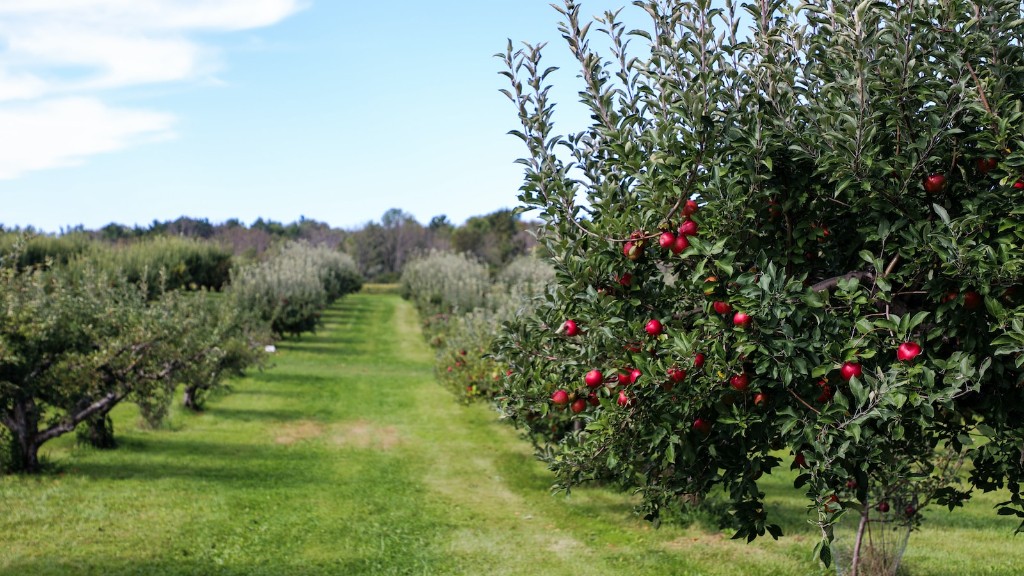An apple tree can be an excellent addition to any property, providing a bounty of fresh apples. When deciding where to plant an apple tree, there are several important considerations to make. Firstly, space should be allocated that provides enough space for the root system of the tree to spread. Secondly, an apple tree requires a significant amount of sunlight in order to fruit and grow. Thirdly, make sure the soil is in good condition by testing it with a soil test kit. Furthermore, consider the environment and climate of your area as certain apple trees are suited to certain areas. Finally, inquire about the type of rootstock the tree is grafted onto. All these considerations will help to determine the most appropriate place to plant an apple tree.
Rooting and Sunlight Requirements
When planting an apple tree, it is essential to consider the rooting and sunlight requirements of the tree. A generous area of soil should be allocated to allow the root system of the tree to expand. It can be helpful to dig a large planting hole to start, as the tree may grow larger than expected. Secondly, the chosen area should have plenty of of direct sunlight. The sunny area should receive at least 8-10 hours of direct sunlight throughout the day, allowing the apple tree to produce fruit and receive nutrition.
Soil Conditions
For a successful and healthy apple tree to grow, the soil conditions of the chosen area should be taken into account. Soil drainage and pH levels can affect the health of the tree, and any nutrient or mineral deficiencies will be quickly noticed. It is important to conduct a soil test before planting an apple tree to make sure the soil is in good condition. The soil test results can be used to identify what amendments are necessary to ensure the tree grows in the most optimal conditions.
Climate Environment
Before planting an apple tree, research should be completed to ensure the chosen tree is suited to the climate environment of the area. Some apple trees require colder climates while others are more suited to warmer temperatures. It is essential to identify the hardiness of the tree to ensure it can survive in the region it is being planted in.
Type of Rootstock
The type of rootstock an apple tree is grafted onto should also be taken into consideration. Rootstock refer to the particular genus or species of root the tree is grafted onto. Depending on the type of rootstock and the desired characteristics that tree, a certain type might work better than another. The type of rootstock will determine the size and shape of the tree and its ability to tolerate soil and climate conditions.
Root Training
In addition to choosing the best place to plant an apple tree, it is important to properly train its roots to ensure the tree develops and grows healthily. Certain methods of root training can help to maximize the growth of the apple tree while minimising stress on the tree. Training roots can involve burying the tree’s roots in trenches so they are not exposed to the sunlight, or burying the tree’s roots in a basket of soil and compost mix, and back-filling once the tree starts to grow.
Pruning
Pruning is also necessary to help shape and maintain the health of the apple tree. Pruning helps to ensure the tree produces the best possible fruit harvest and maintains flexibility in its growth. Pruning also helps to remove dead branches, encourages fruiting, and makes harvesting easier. It is important to prune the tree around 1-2 years after planting, providing more space for the tree to produce fruit and subsequent years of growth.
Fertilisation
Fertiliser has numerous benefits to an apple tree and should be used to promote healthy and robust growth. Applying organic compost or synthetic fertilizers to the soil and the tree’s root structure can help control pH levels, increase the amount of minerals in the soil, and encourage the growth of beneficial microorganisms in the soil. Fertilisers can also help to identify any nutrient deficiency in the soil and amend this to ensure the tree develops a healthy root system.
Companion Planting
Companion planting provides environmental benefits and is an important consideration when planting an apple tree. Planting companion species alongside the tree provides additional nutrients for the soil, increased amounts of organic matter and can help to repel pests. Companion plants should not be planted too close to the tree, as this can take away nutrients and water from the tree. Examples of companion plants include marigolds, cosmos, and lavender.
Pest and Disease Control
Caring for an apple tree requires paying attention to any pest and disease issues the tree might have. It is important to record any signs of pests or disease before they can spread, as they can cause serious harm to the apple tree. Spraying the tree regularly with specialised pesticides can help keep away pests and diseases. Regular inspection of the tree should occur in order for any pest or disease issues to be easily controlled.

